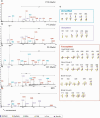Glycomics of cervicovaginal fluid from women at risk of preterm birth reveals immuno-regulatory epitopes that are hallmarks of cancer and viral glycosylation
- PMID: 39242814
- PMCID: PMC11379862
- DOI: 10.1038/s41598-024-71950-x
Glycomics of cervicovaginal fluid from women at risk of preterm birth reveals immuno-regulatory epitopes that are hallmarks of cancer and viral glycosylation
Abstract
During pregnancy the immune system needs to maintain immune tolerance of the foetus while also responding to infection, which can cause premature activation of the inflammatory pathways leading to the onset of labour and preterm birth. The vaginal microbiome is an important modifier of preterm birth risk, with Lactobacillus dominance during pregnancy associated with term delivery while high microbial diversity is associated with an increased risk of preterm birth. Glycans on glycoproteins along the lower female reproductive tract are fundamental to microbiota-host interactions and the mediation of inflammatory responses. However, the specific glycan epitopes involved in these processes are not well understood. To address this, we conducted glycomic analyses of cervicovaginal fluid (CVF) from 36 pregnant women at high risk of preterm birth and 4 non-pregnant women. Our analysis of N- and O-glycans revealed a rich CVF glycome. While O-glycans were shown to be the main carriers of ABO blood group epitopes, the main features of N-glycans were the presence of abundant paucimannose and high mannose glycans, and a remarkable diversity of complex bi-, tri-, and tetra-antennary glycans decorated with fucose and sialic acid. We identified immuno-regulatory epitopes, such as Lewis antigens, and found that fucosylation was negatively correlated to pro-inflammatory factors, such as IL-1β, MMP-8, C3a and C5a, while glycans with only sialylated antennae were mainly positively correlated to those. Similarly, paucimannose glycans showed a positive correlation to pro-inflammatory factors. We revealed a high abundance of glycans which have previously been identified as hallmarks of cancer and viral glycosylation, such as Man8 and Man9 high mannose glycans. Although each pregnant woman had a unique glycomic profile, longitudinal studies showed that the main glycosylation features were consistent throughout pregnancy in women who delivered at term, whereas women who experienced extreme preterm birth exhibited sharp changes in the CVF glycome shortly before delivery. These findings shed light on the processes underlying the role of glycosylation in maintaining a healthy vaginal microbiome and associated host immune responses. In addition, these discoveries facilitate our understanding of the lower female reproductive tract which has broad implications for women's health.
© 2024. The Author(s).
Conflict of interest statement
The authors declare no competing interests.
Figures









References
MeSH terms
Substances
LinkOut - more resources
Full Text Sources
Other Literature Sources

